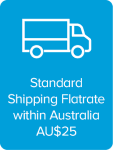|
Henchman |

|
|---|
What is the best Foam for Tool Kit Drawer Organization?
Mar 20, 2024

What is the best Foam for Tool Kit Drawer Organization?
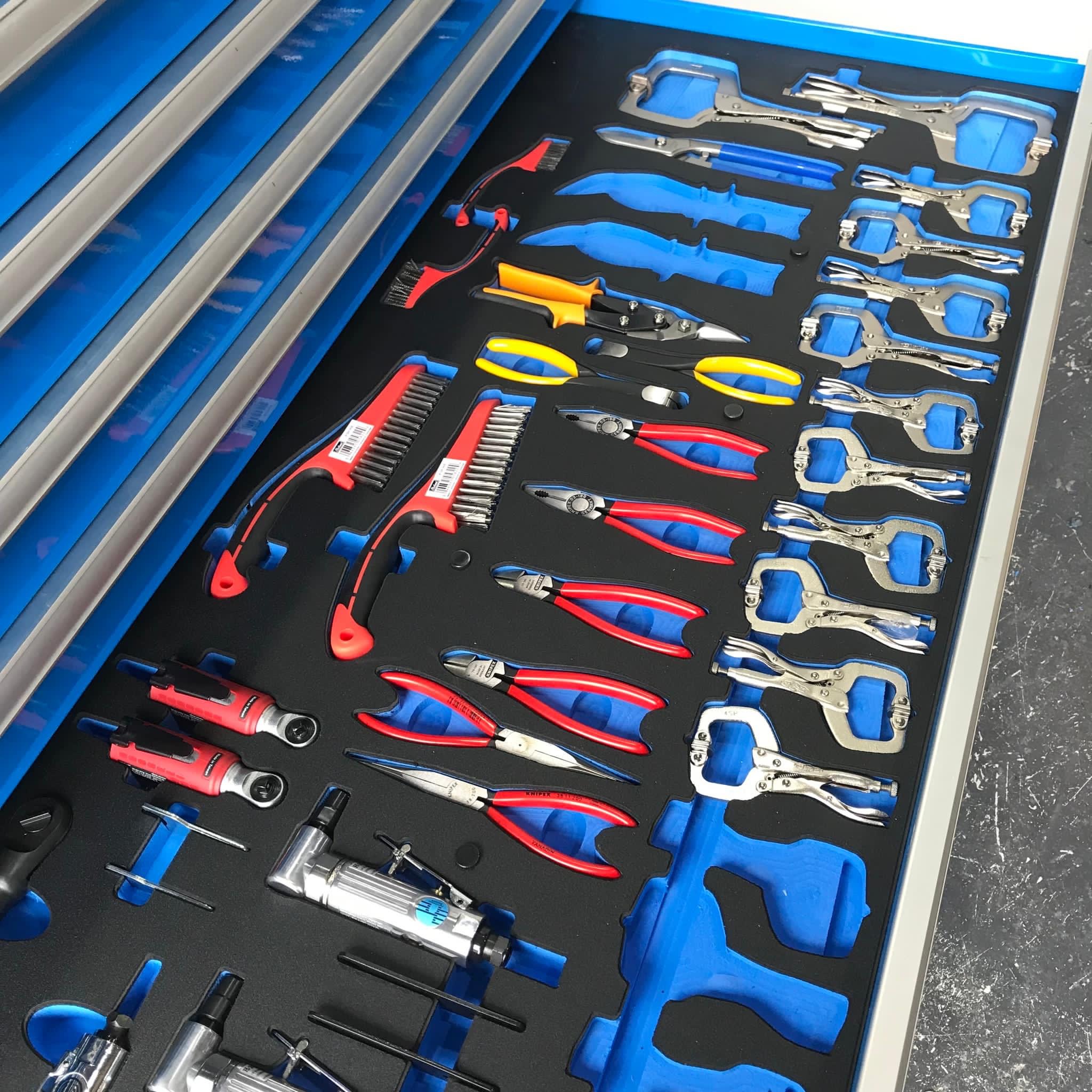 Not being able to find a particular tool when you need it is more than just an inconvenience. The time spent looking for it reduces your productivity, in addition to feeling stressed and annoyed.
Not being able to find a particular tool when you need it is more than just an inconvenience. The time spent looking for it reduces your productivity, in addition to feeling stressed and annoyed.
Organizing your tools in Foam Drawer Inlays makes sure a tool is always returned to its allocated location, making it easy to find. This type of visual tool control also makes it easy to identify which of your tools are actually in your tool storage (toolbox, toolkit, drawer cabinet or even wallboard) or out – which means you need to find and return them.
- Significantly reduce time wasted on searching for a tool – every tool has its dedicated spot in the toolbox
- Reduce time figuring out which tools are missing – immediately see which tools are in use
- Reduce cost of replacing tools accidentally left behind
- Reduce cost for scratched or damaged tools – every tool is protected by the foam and stays in its place
- Work professionally with a clean and organized toolkit
- In Aviation: Follow the requirements of CASR/EASA Part 145 compliance regulations
But which foam type is most suitable when it comes to creating your own tool foam inserts? Read more about the types of foam that can be used for tool organization below, ranked by density.
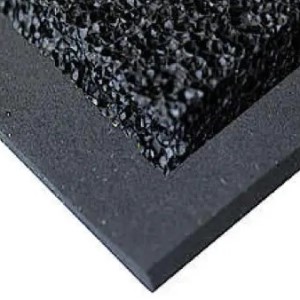
Closed-cell Foam vs Open-cell Foam
Foam cells are bubbles that expanded from the liquid foam mixture during its production. In open-cell foam, these bubbles expand until they burst, leaving behind an interconnected structure, called struts. In closed-cell foam sheets, cells do not rupture, and the thin surfaces between the struts are called windows.
Open Cell Foam Types: Polyurethane (PU), Latex Foam, Dryfast Foam are recognizably soft and have a squishy spongy feel. Even though they are good for packaging, they are not sturdy and durable enough for drawer foam inlays, as they can easily break or rip (increasing the risk of foreign object damage (FOD) in Aviation).
Closed Cell Foam Types: Cross-linked polyethylene (XLPE), polyethylene roll and standard polyethylene (PE) are more rugged and durable, in addition to NOT being water absorbent.
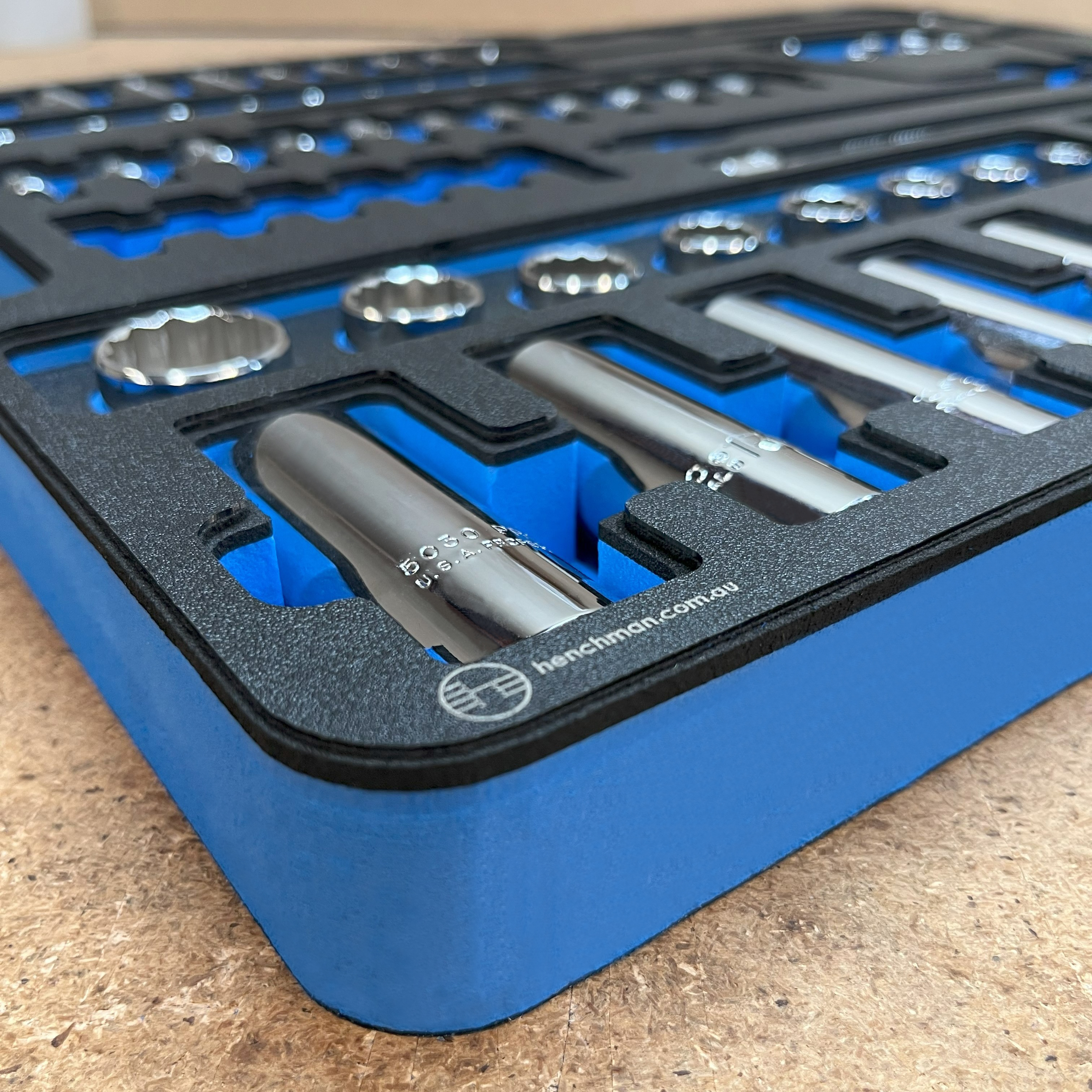
What are Henchman Foam Inlays made of?
The foam for our tool kits has been specially formulated to be the top of its class and specifically designed for custom case inserts and tool foam inlays. It is only available from us.
The distinctive black and bright blue Henchman foam sheets are made up of 4 layers:
- A solid plastic top layer, wipeable and can be laser marked.
- A thin black foam layer for heightened contrast and protecting your fingers from potentially sharp edges.
- The main bright blue foam layer, which is a custom blend of XLPE and EVA Foam.
- A thin plastic bottom layer, providing rigidity and protection against scratches and moisture.
Minicel Foam / EVA Foam (chemically crosslinked ethylene-vinyl acetate)
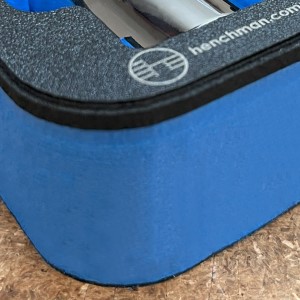 Minicel foam is a fine-celled foam of superior quality making it ideal for projects that require a thicker foam for durability and longevity. Minicel foam is a high-performance ethylene-vinyl acetate (EVA) foam that is more resilient than crosslinked polyethylene foam (XLPE). With a smooth and consistent surface, coupled with exceptional physical and chemical properties, Minicel offers a reliable solution for a wide array of applications in which durability is paramount.
Minicel foam is a fine-celled foam of superior quality making it ideal for projects that require a thicker foam for durability and longevity. Minicel foam is a high-performance ethylene-vinyl acetate (EVA) foam that is more resilient than crosslinked polyethylene foam (XLPE). With a smooth and consistent surface, coupled with exceptional physical and chemical properties, Minicel offers a reliable solution for a wide array of applications in which durability is paramount.
Minicel closed-cell foam works well as thermal insulation, industrial gaskets, padding in sports and work equipment, shin guards, helmets, insulating hot tubs, yoga mats or exercise mats. In addition, it can be used in boating and marine as boat deck mats, flotation equipment, custom seating and padding in kayaks – due to its low moisture permeability and high buoyancy.
- Superior resiliency
- Fine-celled
- Matte finish
- Toughness with great flexibility
- Low water absorption
- Impervious to mildew, mold, rot, and bacteria
- Good thermal insulator
- Excellent chemical resistance
- 100% recyclable
While the foam inlay shape itself is easily cut with a sharp utility knife, scalpel, or hot blade, EVA and XLPE foam types require a CNC router or Dremel to cut the individual tool pockets. This makes them less suitable for DIY tool drawer organization.
Cross-Linked Polyethylene Foam (XLPE Foam)
Chemically cross-linked polyethylene foam is an extremely fine closed-cell foam, ideal for applications that require thicker foam. With a more smooth and pleasant feel than EVA foam, combined with superior physical and chemical properties, cross-linked polyethylene foam can be used in a similar array of applications.
XLPE or Polyolefin Foam works well commercially as thermal insulation, construction expansion joints, and industrial gaskets. It is also used as packaging and in flotation equipment. XLPE can also be carved and sanded for one-of-a-kind DIY projects.
- Resilient
- Extremely fine-celled
- Matte finish
- Excellent strength and shock absorption
- Low water absorption
- Excellent buoyancy
- Impervious to mildew, mold, rot, and bacteria
- Good thermal insulator
- Excellent chemical resistance
- Nontoxic and contains no CFCs, HCFCs, or hydrocarbon blowing agents
- 100% recyclable
- Similar to Volara in the US, Alveolit in Europe and Softlon in Japan and Australia
Volara foam is a general-purpose Polyolefin foam, but FDA approved for use in food and other health applications, due to its strong chemical and microbe resistance.
The two foams with the finest cellular structures are neoprene and cross-linked polyethylene (XLPE). They are constructed of incredibly small cells, even though they might look and feel more like a solid piece of flexible plastic or rubber.
Neoprene Foam
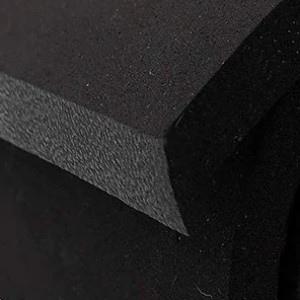 Neoprene foam, dark charcoal grey in color and also known as “Monarch”, is a soft, flexible, and durable form-fitting sponge rubber that provides good thermal and moisture insulation. It is resistant to ozone, sunlight, oxidation, as well as many chemicals and petroleum derivatives. Neoprene will also resist breakdown by water and air because of its unique molecular rubbery structure. Practical applications of neoprene foam include sports equipment like wet suits, gloves, knee pads, and elbow pads. In an industrial capacity, neoprene can be used as insulation, expansion joint filler in masonry and concrete work, gaskets, and weather stripping.
Neoprene foam, dark charcoal grey in color and also known as “Monarch”, is a soft, flexible, and durable form-fitting sponge rubber that provides good thermal and moisture insulation. It is resistant to ozone, sunlight, oxidation, as well as many chemicals and petroleum derivatives. Neoprene will also resist breakdown by water and air because of its unique molecular rubbery structure. Practical applications of neoprene foam include sports equipment like wet suits, gloves, knee pads, and elbow pads. In an industrial capacity, neoprene can be used as insulation, expansion joint filler in masonry and concrete work, gaskets, and weather stripping.
Both neoprene and XLPE are consistent throughout the sheet, without getting denser near the outer edges. Neoprene is a dense, more rubbery material, in most formulations softer and more flexible than XLPE, while cross-linked polyethylene is more rigid while usually being lighter.
Although most commonly known as a thin sheet, Neoprene is also available in thicker blocks that can be cut with a sharp utility knife, scalpel, or hot blade.
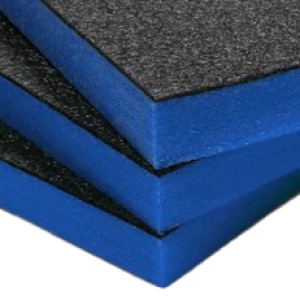
Standard polyethylene foam (PE Foam)
Polyethylene foam is a strong and resilient shock absorbing closed cell foam, ideally suited as packaging and padding. Polyethylene is available in sheets, cylinders, and tubes that are used for expansion joint filler (backer rod), insulation, buoyancy components, and packaging. Being more plastic-like than other foams, PE has a sheen, unlike the matte finish of the closed-cell foams above, that appear more rubbery.
It is versatile and can be used across a wide range of applications, from archery targets and long term storage to sill plate gaskets and bond breaker in masonry work. It is also made in an Anti Static formulation for the storage, packaging, and transportation of sensitive electronics.
- Closed cell, chemically cross-linked structure
- Glossy finish
- Lightweight
- Shatterproof
- Non-dusting
- Excellent buoyancy
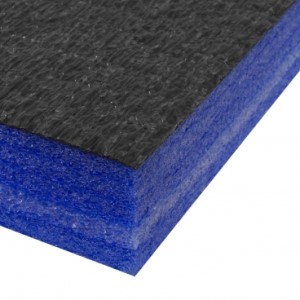 Superb strength and tear resistance
Superb strength and tear resistance- Excellent shock absorption
- Impervious to mildew, mold, rot, and bacteria
- Superior water, chemical and grease resistance
The cells of polyethylene are rather large, similar to Dryfast, but are completely sealed off as enclosed cells. Lower density PE consists of larger cells and high-density PE consists of smaller cells.
PE is used for most Cut and Peel foam inlays. For tool drawer organization applications, the top layer of the foam can be cut using a utility knife before peeling it off the bottom layer, making it suitable for most DIY tool foam projects. But in the Aviation industry it can turn into a safety hazard called foreign object debris (FOD) due to the layered structure of the foam – when parts of the foam layer peel off.
It also is a lot softer than XLPE or EVA and therefore more suitable for tool organization in toolbox drawers - not for multiple inlays stacked inside a portable case, that are meant to be taken out of their case.
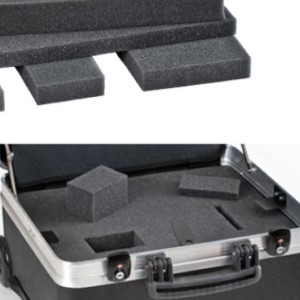
Pick and Pull Grid Foam
Pick and Pull Grid Foam is a lightweight low-density variant of polyethylene (PE) foam with a cube design precut into the top layer, making it easy to grab and pull a square to create a basic cutout to fit around any size or shape object. Absorbing impacts and vibrations, it is strong enough to protect the contents of a package without drastically increasing the weight, keeping shipping costs to a minimum. Applications include mailing artwork or breakables, storing firearms, weapons, and bulkier equipment, as well as computer parts. Other applications include cost-effective acoustics, cases, and packaging.
The foam-filled options of the Explorer Transit Cases Range come with this kind of foam.
Expanded Polystyrene Foam (EPS) / Styrofoam
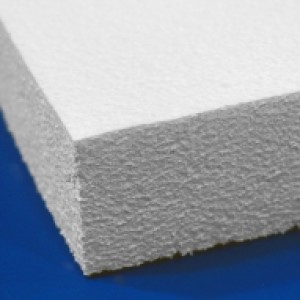
Expanded Polystyrene (EPS) has the most unique foam cell structure among closed-cell foam, and as a result, is the most recognized. The omnipresent white foam, typically seen as coffee cups and packaging material, is also known as “bead board” because of its cellular structure. During the material’s formation, tiny beads of styrene expand to more than 40 times their original size and are compressed together into blocks, sheets, and molded shapes. These beads are easily visible and can be picked out.
Nevertheless, Polystyrene foam is a sturdy and lightweight foam that’s very popular for personal projects like arts and crafts, as well as for commercial uses like geotechnical filler in construction. Surprisingly strong, EPS’s unique closed cell structure offers excellent resistance against moisture and water vapor, and will not rot, mold, or mildew. EPS sheets have a superior R-value which makes them an outstanding insulation product in homes and as hot tub covers.
EPS requires hotwire cutting for smooth edges, otherwise it tears and flakes into its beads. This characteristic also makes it unusable in Aviation Tool Kits, as it poses a very high risk of breaking and becoming Foreign Object Debris (FOD).
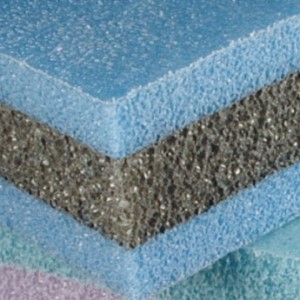
Expanded Polypropylene Foam (EPP)
Being a rigid closed-cell foam material with great compression and impact resistance, Expanded Polypropylene is a versatile material that can be used for many applications. With a broad loading range, high energy absorption, and great servicing temperature, EPP is ideal for displays, packaging, thermal insulation, heavy duty packaging, signage, roofing strips, and more.
EPP is used widely in the aero modelling hobby due to its superior strength and its resistance to aero fuels. High density grades are used where energy management is important, such as automotive bumpers and interior passenger safety components. Low density grades are used for packaging applications, and medium densities find applications in furniture and other consumer products.
Similar to EPS, EPP also requires hotwire cutting for smooth edges, otherwise it tears and flakes into beads.



